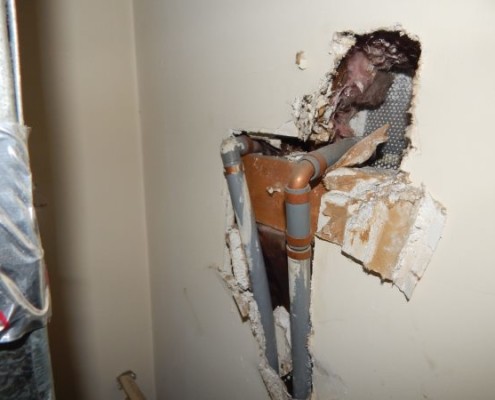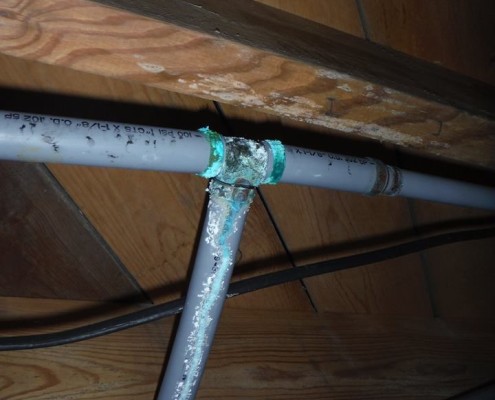Is there a bomb ticking under your sink?
Water. The substance of life. We can’t live without it. And there’s nothing better than indoor plumbing. Don’t think so? Ask your favorite senior sometime about walking through 12 inches of snow in sub-zero temperatures just to use the bathroom. But with all the greatness that indoor plumbing holds, people have made a few mistakes along the highway of plumbing technology.
Between 1978-1995 plumbers all across the country fell in love with a product known in the industy as simply PB (short for Polybutylene).
This stuff revolutionized the plumbing of a home. Speed is the name of the game when it comes to construction, and the faster you can get a job done, the faster you can get another job started. PB was the key to the Promised Land to plumbers. It cut install time and material cost in half! Which, of course, doubled profits. Win-win right? For awhile, yes. However, PB pipe had a deep dark secret that was lurking in the shadows…
I was in a home just last week doing a Louisville home inspection on a pretty nice house. This was the second home inspection for the same client in two weeks. The first home was suspect, to say the least. I thought that she had found a winner this time…then I opened the kitchen cabinet under the sink. And buried behind all the usual under-the-sink “stuff” sat a bomb.
There, with time ominously ticking away, was PB pipe.
Nothing but fire will destroy a home faster than water. PB would prove this to be true. You see, PB water supply lines had one critical fault. They failed at the crimp joints, flooding homes in the process. Many, many people have come home from a hard day at work to find water pouring out of their front door. Nearly everything they own destroyed in a flash.

How can you tell if you have PB pipe in your home?
Exterior – Polybutylene underground water mains are usually blue, but could be gray or black. They are normally 1/2″ or 1″ in size, and may be found coming into your home through the basement wall or floor, concrete slab or crawlspace. You should also check at the meter by the street. Although you may have copper in the home, your main line could be a PB buried in the yard.
Interior – Polybutylene used inside your home can be found near the water heater, running across the ceiling in unfinished basements, and coming out of the walls to feed sinks and toilets. It is normally battleship grey in color and could have a red stripe on it. You may also find the text PB2110 SRD11. Bear in mind that you may have PB concealed in the walls, and copper “stubs” protruding through the walls for sinks and toilets, giving you the false impression that you do not have PB in your home.
What is the problem with PB pipe?
It is not certain what the exact issue is. Many professionals suggest that the chemicals added to city water supplies, such as chlorine, cause the plastic resin in PB to break down over time from the inside out. This means you CANNOT look or touch the PB in a home and tell if it is failing. Blame has also been placed on installation error. While it is very feasible that problems could arise from a faulty install, it is difficult to find and check EVERY connection in a home. That could easily amount to the hundreds of connections. The reality is there is no safe or good PB installs. Many plumbers now state that it’s not a matter of if but when it will fail.

What do you do if you find PB in your home?
If, after reading this, you look under your sink and see what appears to be PB, call a plumber. Tell them you think you have PB in your home and you would like to get it checked out. Just because you’ve never had a leak, doesn’t mean it won’t happen. This stuff is calm like bomb. If you are looking at a home to buy and suspect PB plumbing in the home, get an estimate on having the home re-plumbed with copper, PVC, or PEX. It might not be a deal killer if you don’t make it one.
Call your insurance company. Many won’t cover a home with PB installed in it. Although the question may never have come up while you were getting the property covered, it may be hard times for you if they deny the flood claim because of some fine print on page 538 of your contract.
Be proactive. It’s always cheaper in the long run. You may find PB in your home, and think, “It’s fine, this stuff has been here since 1990.” While this may be the case, you may come home next week and find you have to replace not only the plumbing, but the drywall, carpet, tile, cabinets, sub floor, baseboard, insulation, doors, cat, dog, etc… You get the idea. It’s never a problem until it leaks.




The facts that have been discussed here are really important. Thank you so much for sharing a great post.